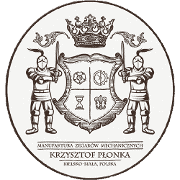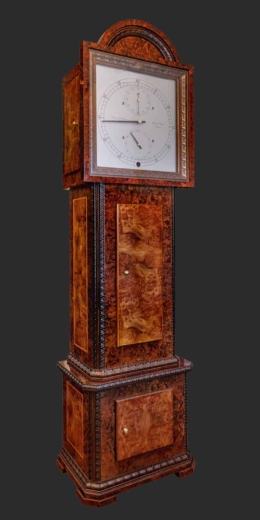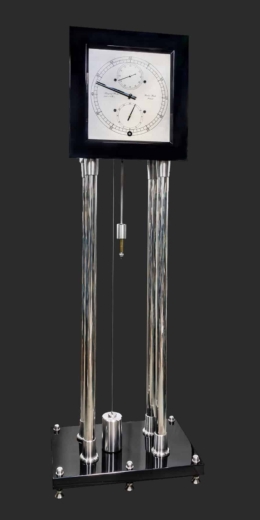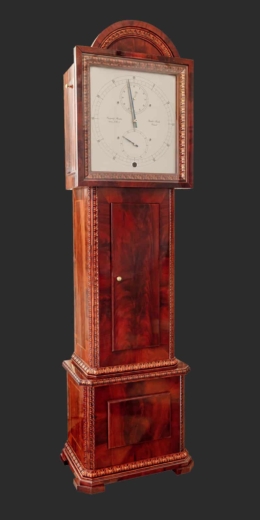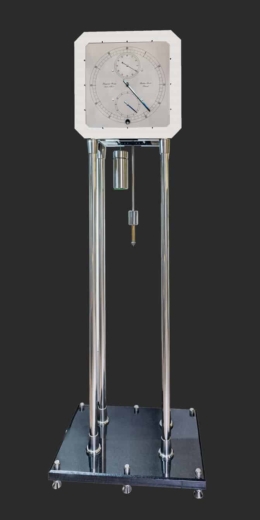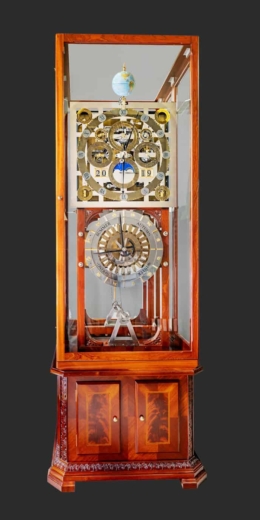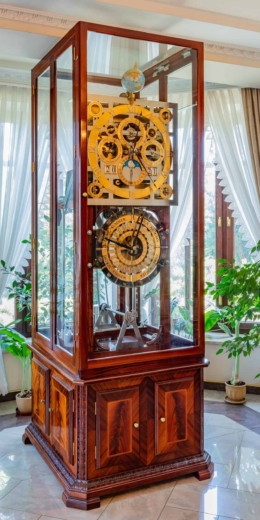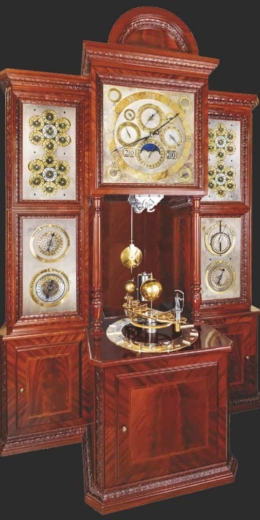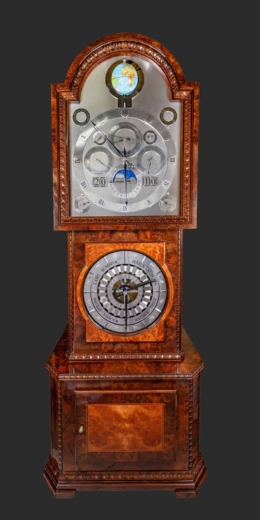Project
The Great Astronomical Skeleton Clock 2011-2015
The intricate operation of this magnificent mechanism can be observed thanks to its glass structure.
The use of state-of-the-art solutions guarantees meticulous measurements and accurate readings. Time, date, moon phases, time zones or zodiac signs are barely some of the possibilities this sophisticated astronomical floor clock possesses.
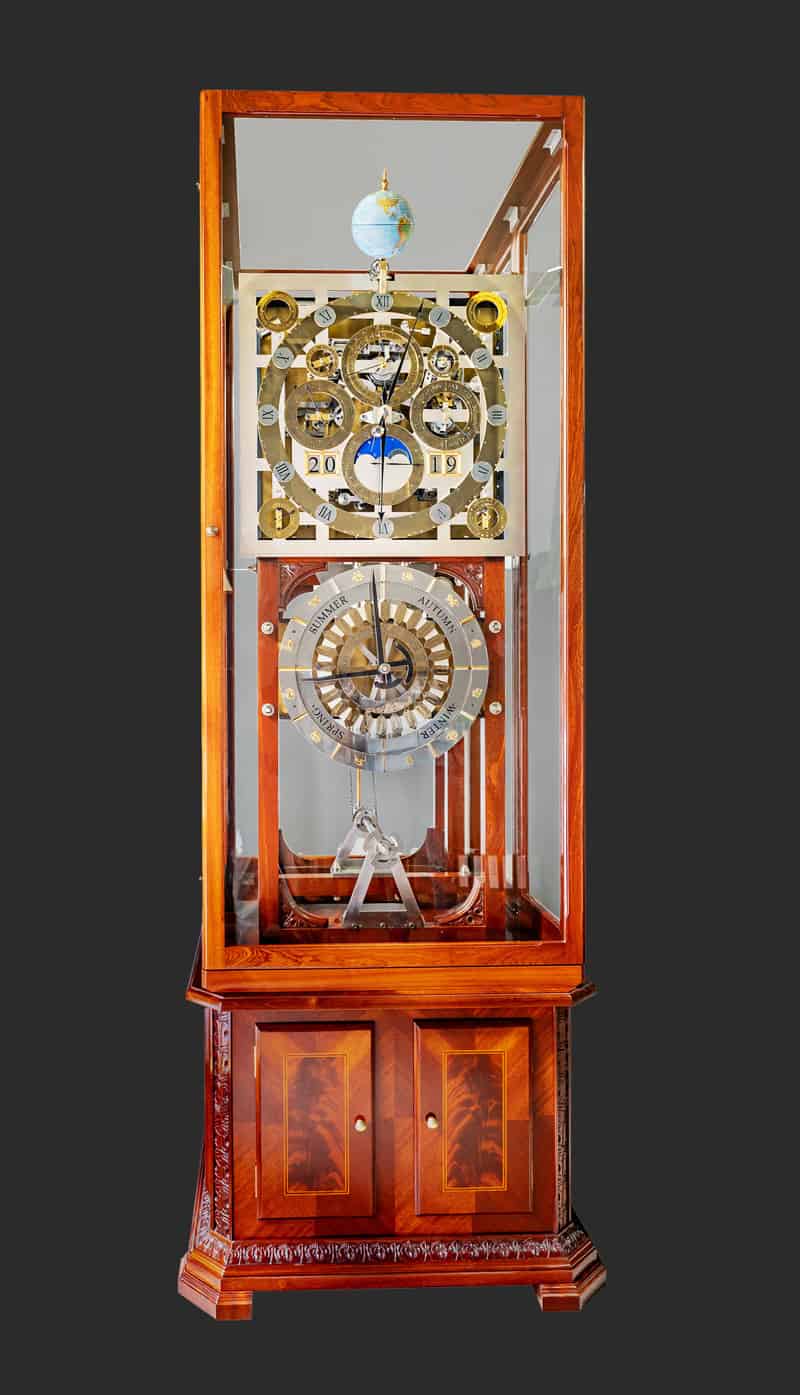
ASTRONOMICAL
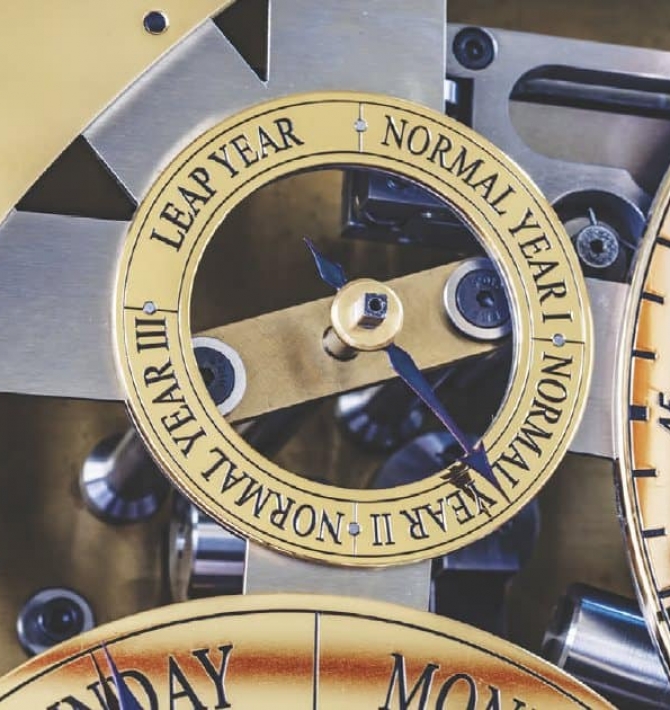
10 years of work
The creation of the Great Astronomical Skeleton Clock took 10 years, including the assembly which took 4 years in itself. The project was finally completed in 2015.
A majestic, unique work of watchmaking art.
At the same time, a precise, functional addition to an elegant, original interior.
The Great Astronomical Clock 2011-2015 is a floor skeleton clock that is the perfect combination of fine and applied art.
It also represents a decade of persistent, patient and committed work. This absolutely ingenious and unique clock is the culmination of 10 years of carefully thought out, precise work. From the author's concept, through the plans for the subsequent mechanisms, to the final and very impressive combination into a coherent, functional whole.
The superb mechanism, the operation of which can be observed thanks to its glass case, guarantees precise measurements and accurate readings.
Time, date, moon phases, time zones or zodiac signs are barely some of the possibilities this sophisticated astronomical floor clock possesses.
FUNCTIONS
Functions/indications
The clock has the following functions/indications:
1. second hand
2. hour dial – 12 hours
3. hour dial – 24 hours
4. date indicator
5. days of the week
6 months
7. years
8. ordinary/leap years
9. declination of the sun
10. sunrise
11. sunset
12. phases of the moon
13. time zones
14. seasons
15. zodiac signs
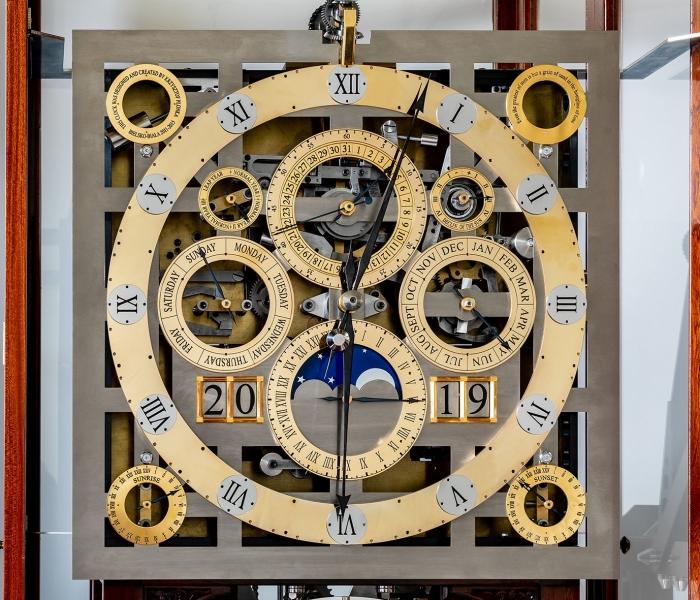
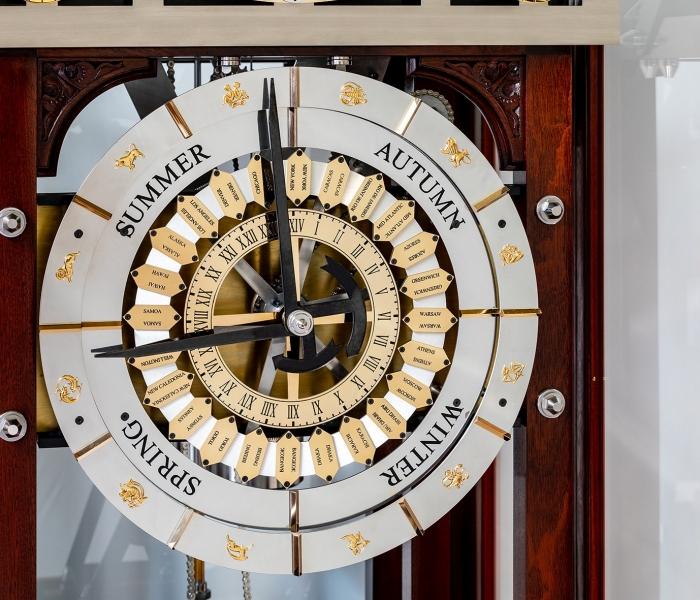
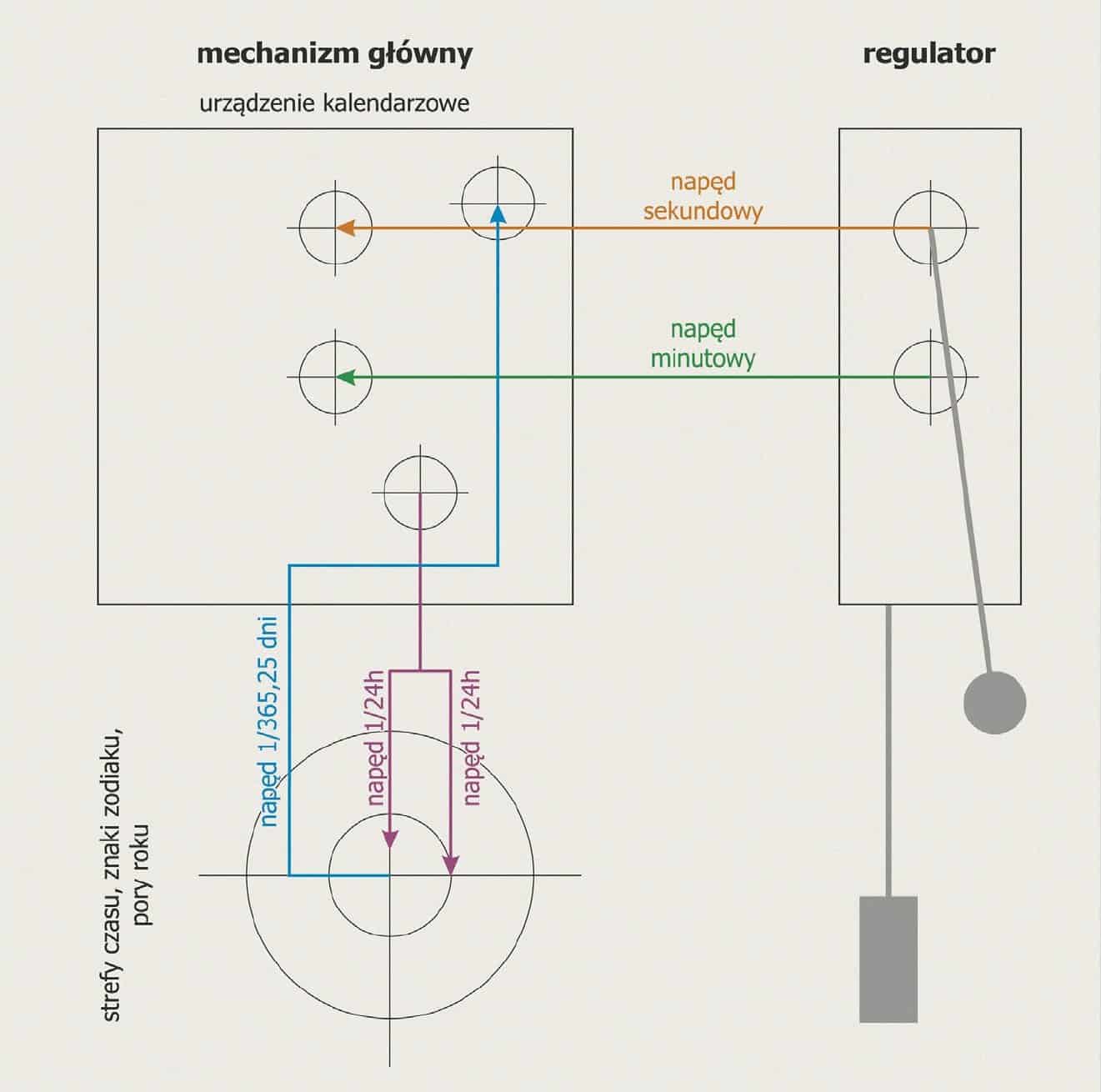
DIAGRAM
Diagram
of operation.
MECHANISMS
Basic mechanisms and parts
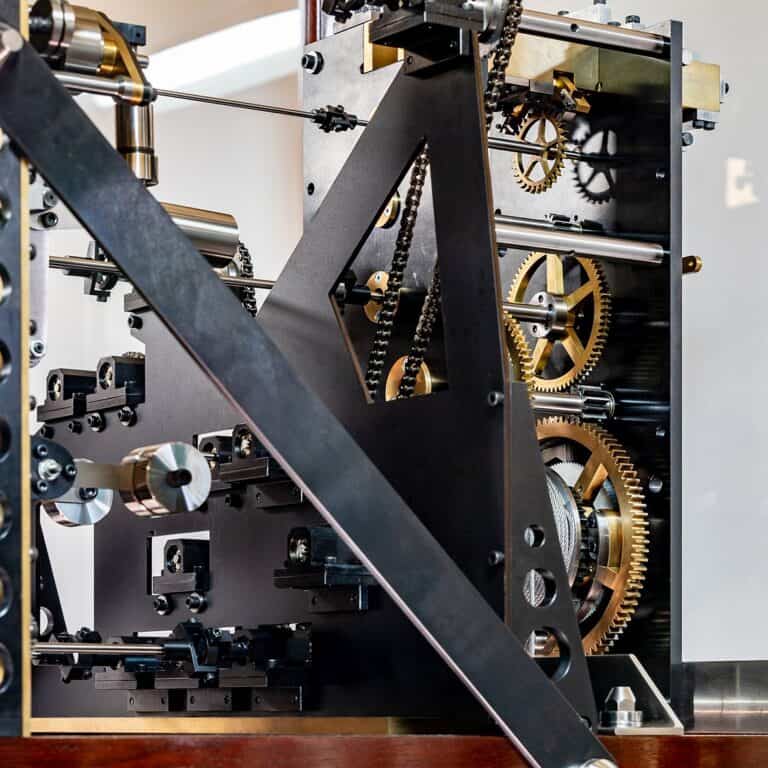
- drive –
regulator
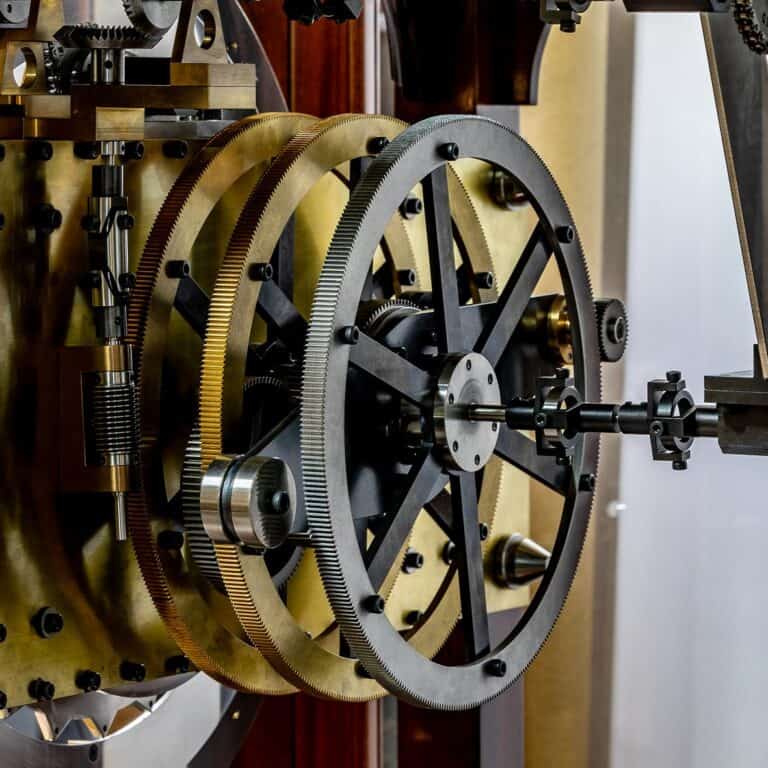
- annual gear
mechanism
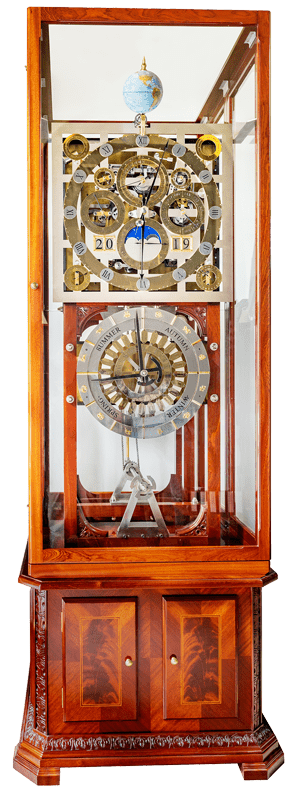
- clock case
(base, display case)
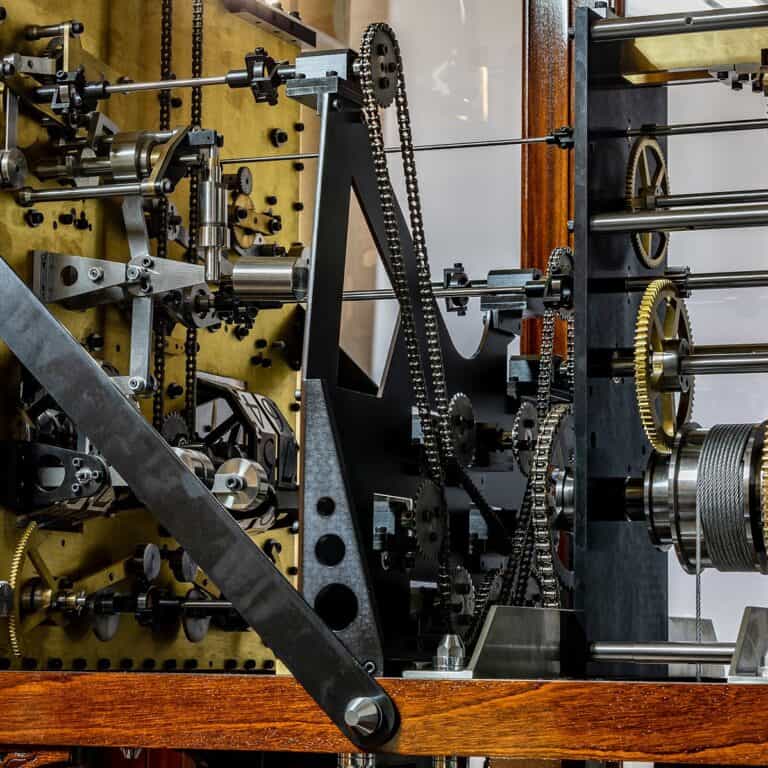
- "transmission"
mechanisms
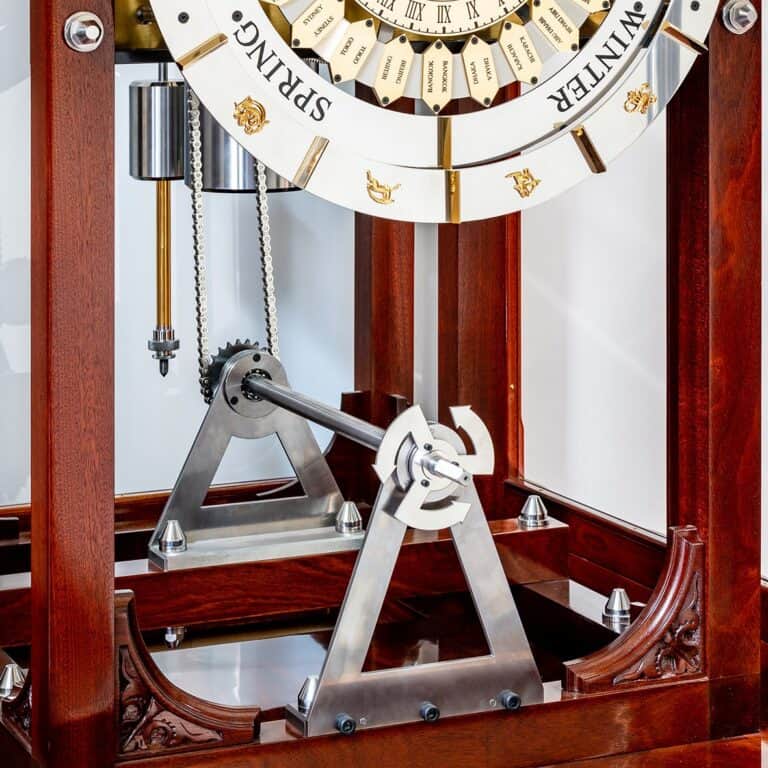
- Mechanism
of the tensioning
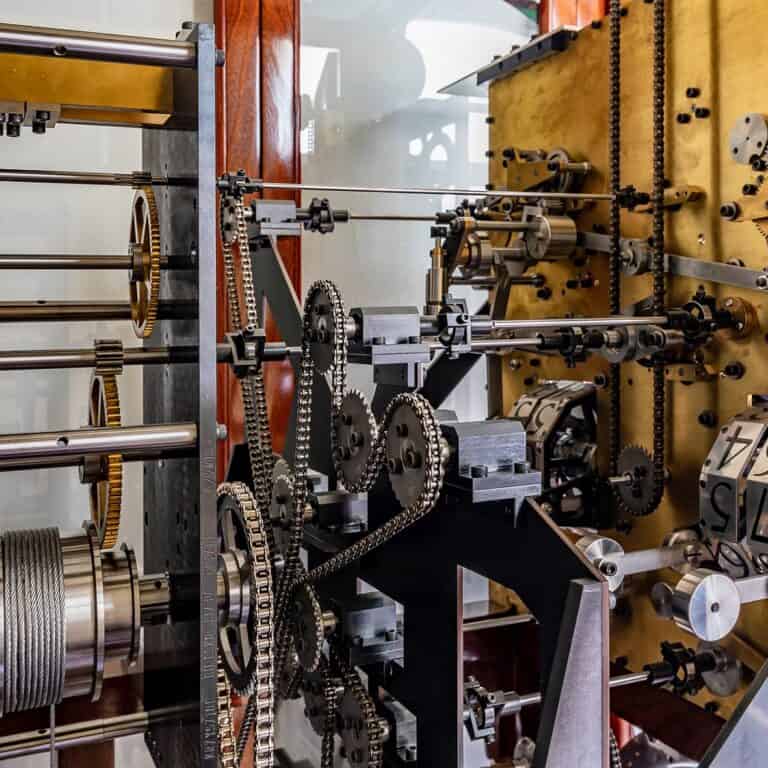
- highly complex main mechanism
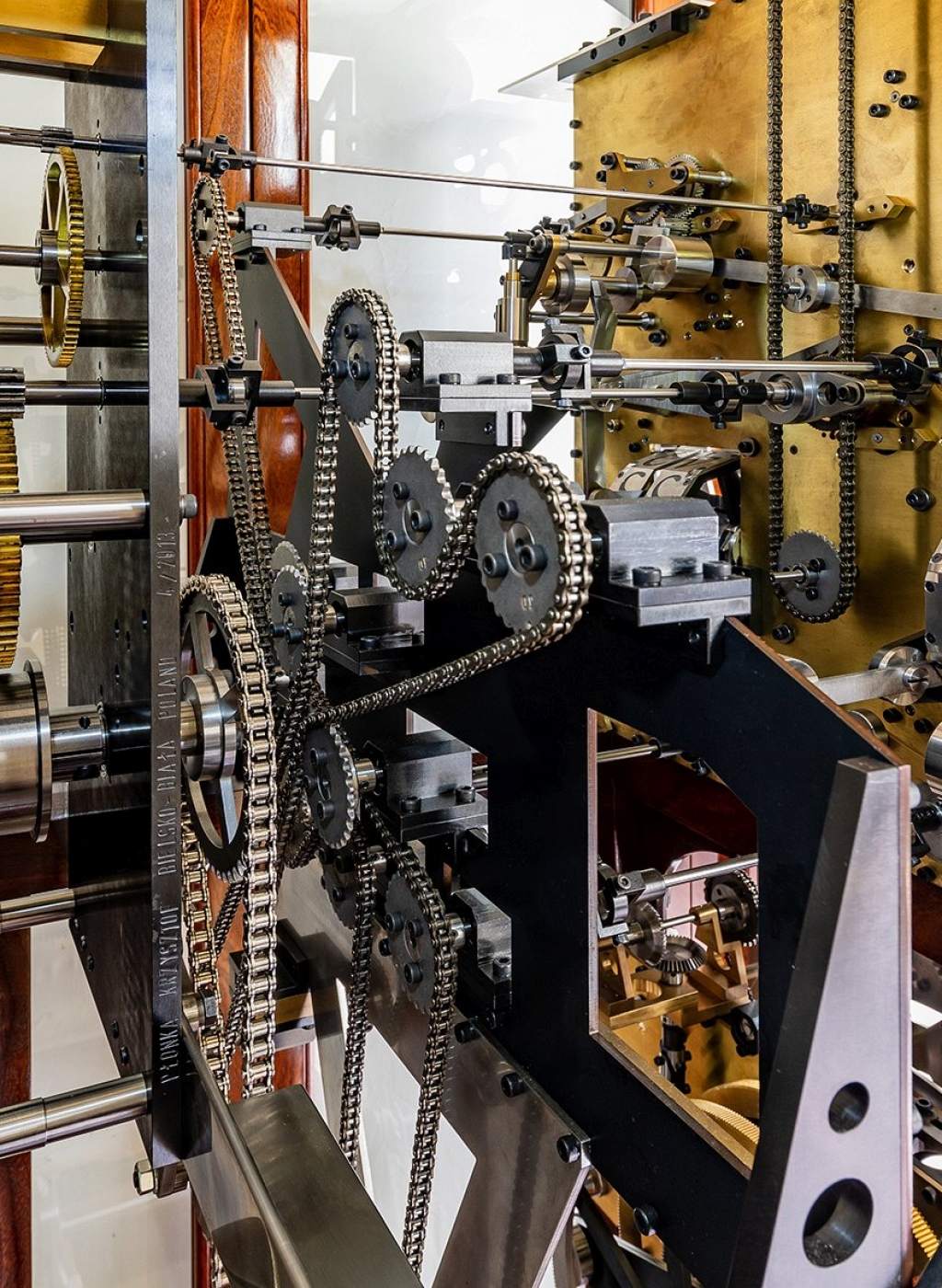
DESCRIPTION OF OPERATION
Description of operation
The clock drive (regulator) drives the seconds hand axis and the minute hand axis of the main mechanism. The main mechanism controls the movement of the hands visible on the main dial and the year indications in the four fields, in addition to the "sunrise", "sunset" and "sun declination” indications.
The main mechanism acts as a perpetual calendar. Depending on whether the year is ordinary or a leap year, it adjusts the number of days in a given month. No date adjustment is required. The main mechanism drives the annual gear, via the transmission mechanism, at a speed of 1 revolution/24 hours, and the 'time zone' indication dial at the same speed.
The annual gear axis makes 1 revolution in 365.25 days, allowing for a leap year (1461 days in total) in a four-year cycle. The ratio of 1/365.25 days has been achieved by using a worm gear with a planetary circuit that makes 1 revolution in 4 years. The annual gear, in addition to the "season" and "zodiac signs” indication drive, controls the "sunrise", "sunset" and "sun declination" indications on the main dial via the transmission mechanism. Thanks to the correction, the annual transmission also does not require adjustment (repositioning).
Interruptions in the operation of the clock result in erroneous settings of the functions such as "seasons", "zodiac sign", "sunrise", "sunset", and "sun declination" and makes it necessary to correct the setting.
DRIVE MECHANISMS
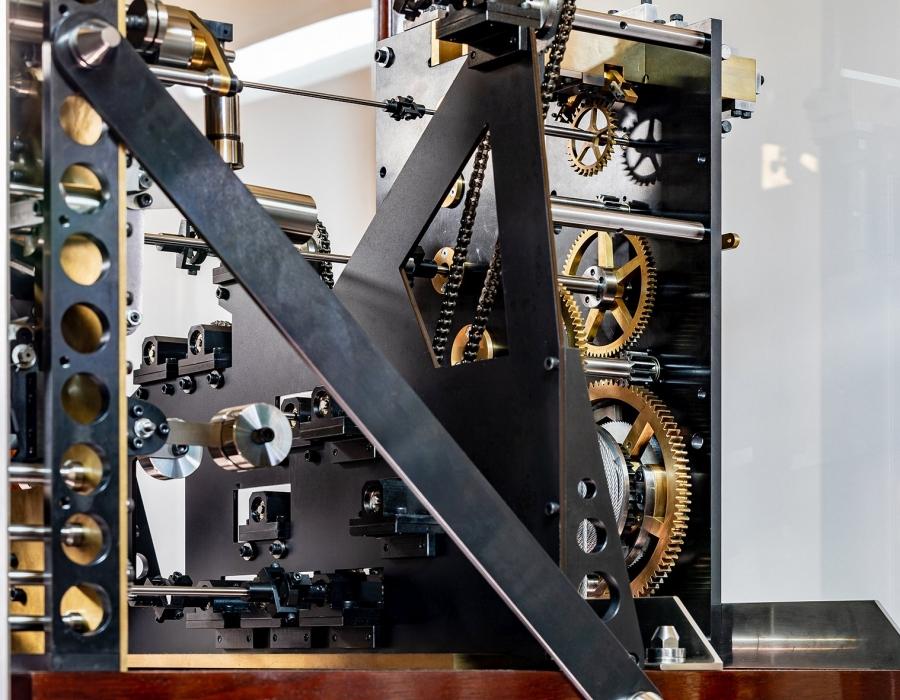
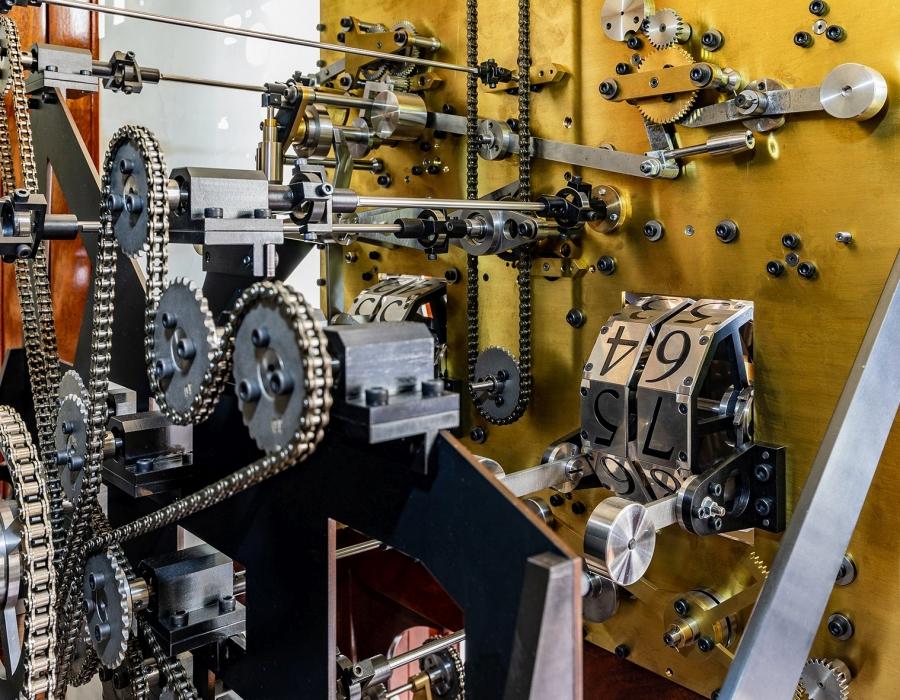
Drive mechanism (regulator)
The clock mechanism is a modern design the size of a small tower clock. Ball bearings have been used for all axes of the mechanism due to the need to increase the durability of the mechanism and reduce rolling resistance. The pendulum and anchor have been fitted with two knife supports resting on the prism sockets of the mechanism. The anchor-pendulum connection has been equipped with a pendulum swing regulator and a safety device to protect the capture wheel and the pallets from damage in the event of a pulse failure. The seconds pendulum has thermal compensation. The mechanism has a cable tension, with a power reserve of approximately 5 days.
TRANSMISSION MECHANISM
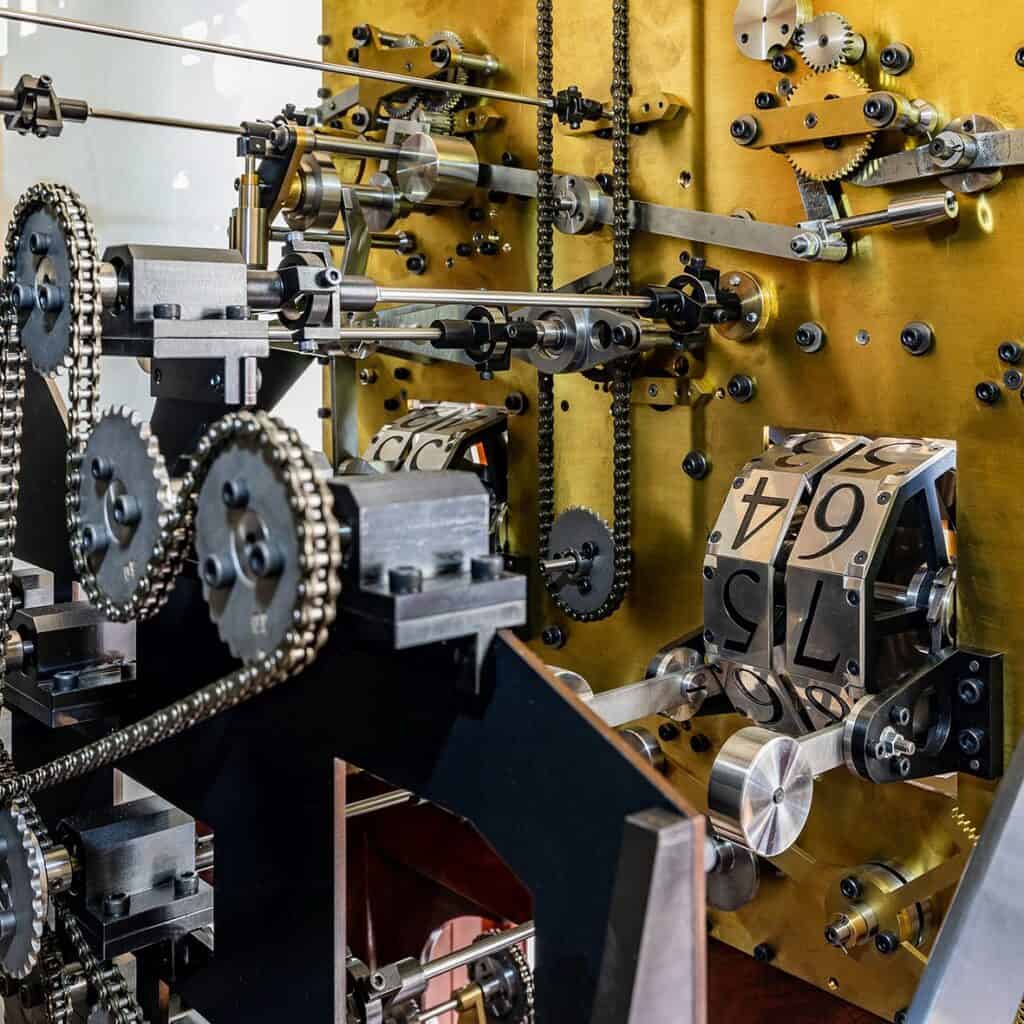
Transmission mechanism
The transmission mechanism is located between the drive (regulator) and the main mechanism. It distributes the drive in multiple directions and planes via sprockets, Gall chains, and drive axles. Bodies with roller-bearing-mounted sprocket axles have been fixed on the mechanism plate. Each sprocket system has adjustable chain tension, and the drive axles are fitted with longitudinally sliding Cardan joints to protect the entire linkage system from additional rolling resistance. All structural components of the drive mechanism involved in the clock's operation have been heat-treated to increase the durability of the components.
Tensioning mechanism
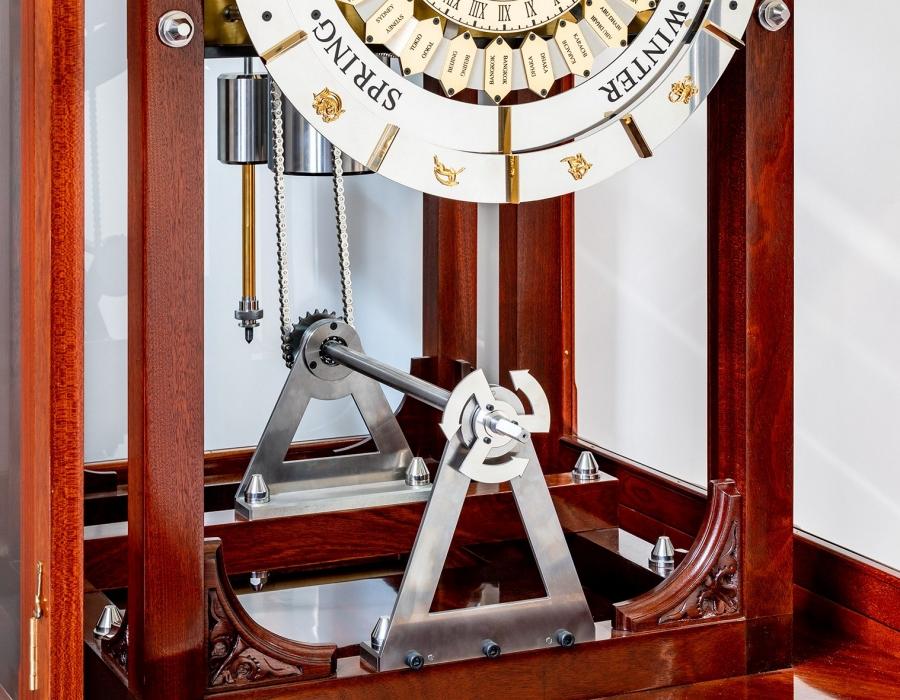
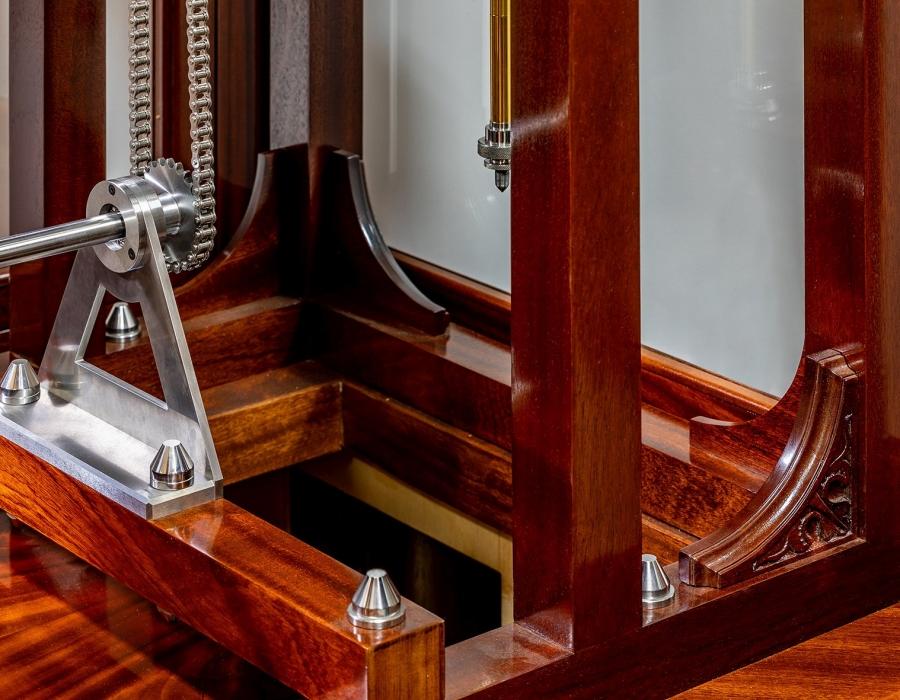
Mechanizm naciągu
In order to wind up the clock a crank is applied to the quadrant of the winding axis. The axis of the tensioning mechanism is attached to the wooden clock case by two brackets fitted with ball bearings to reduce rolling resistance. A sprocket mounted on the tension axle via a Gall chain and a second sprocket integrated into the axis of the clock drum enables tension to be attained.
Main mechanism
Main mechanism
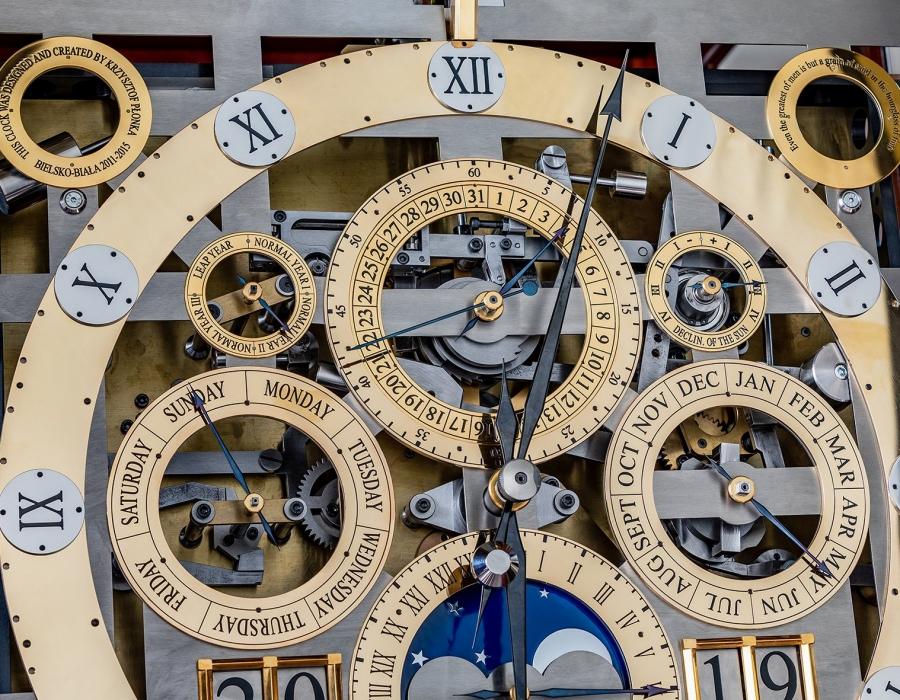
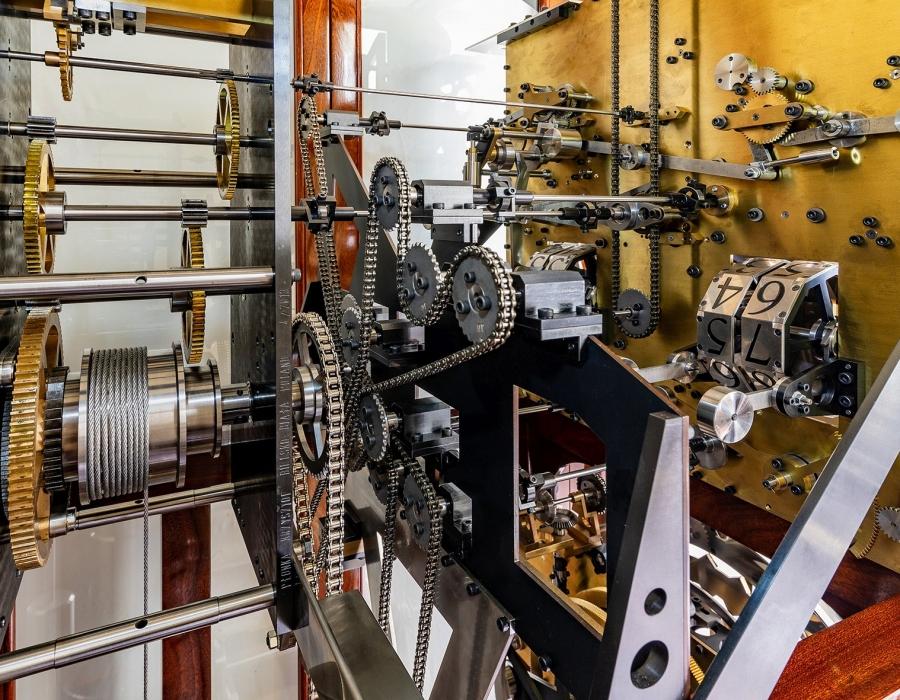

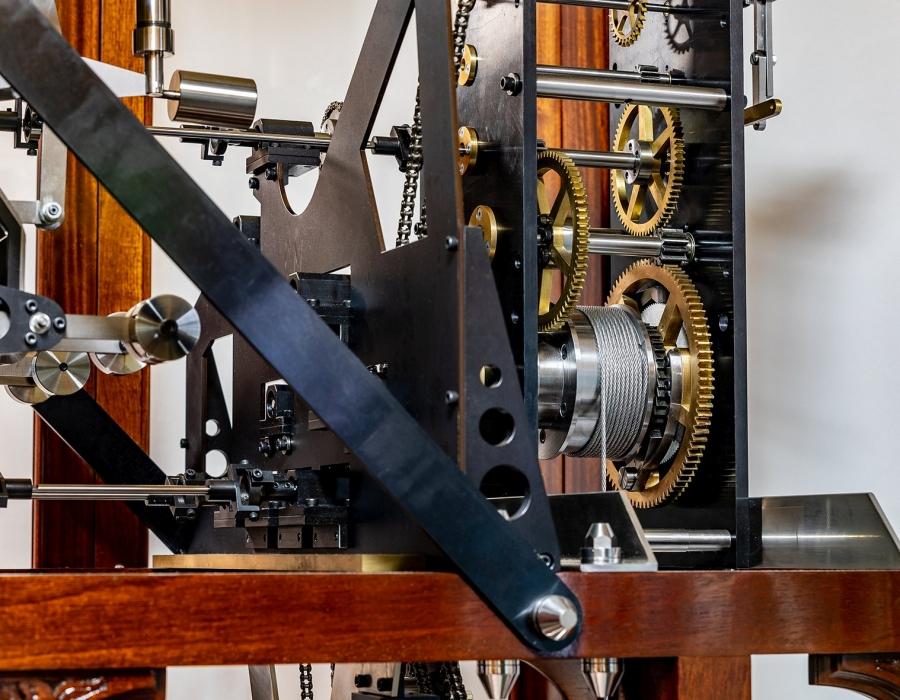
The main mechanism of – Krzysztof Płonka's astronomical skeleton clock is a highly complex calendar device that controls all the clock's functions.
The central axis of the main mechanism makes 1 revolution per hour – this is the minute axis. Through gears with a gear ratio of 1 revolution/24 hour, the drive of the date display, days of the week, moon phase, GMT time indications – (24-hour dial), globe drive, time zone drive, and worm annual gear drive (worm gear with planetary cycle) have been obtained. A gear system with a ratio of 1 revolution/12 hours drives the hour hand.
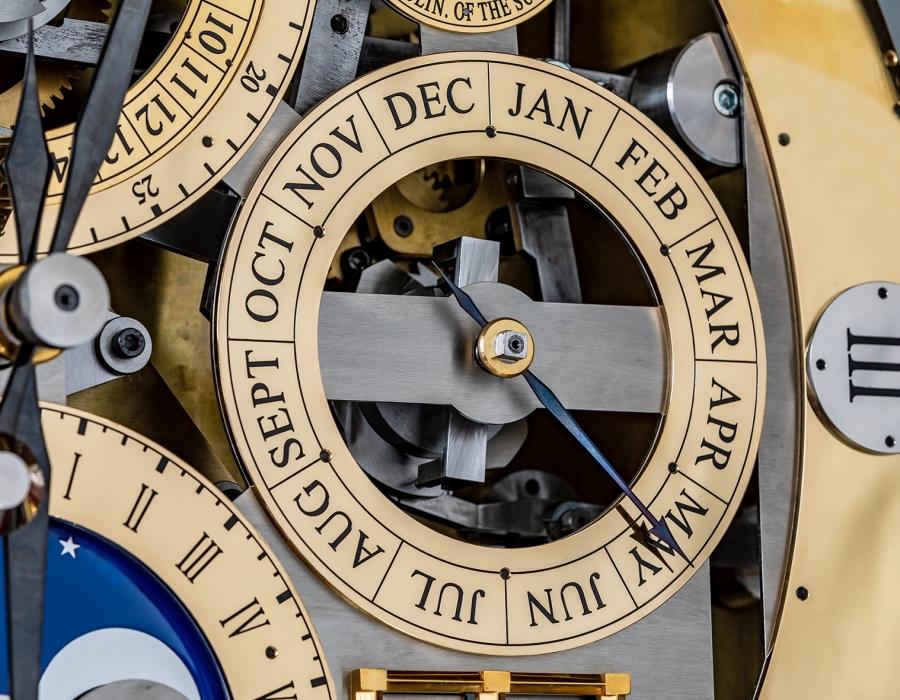
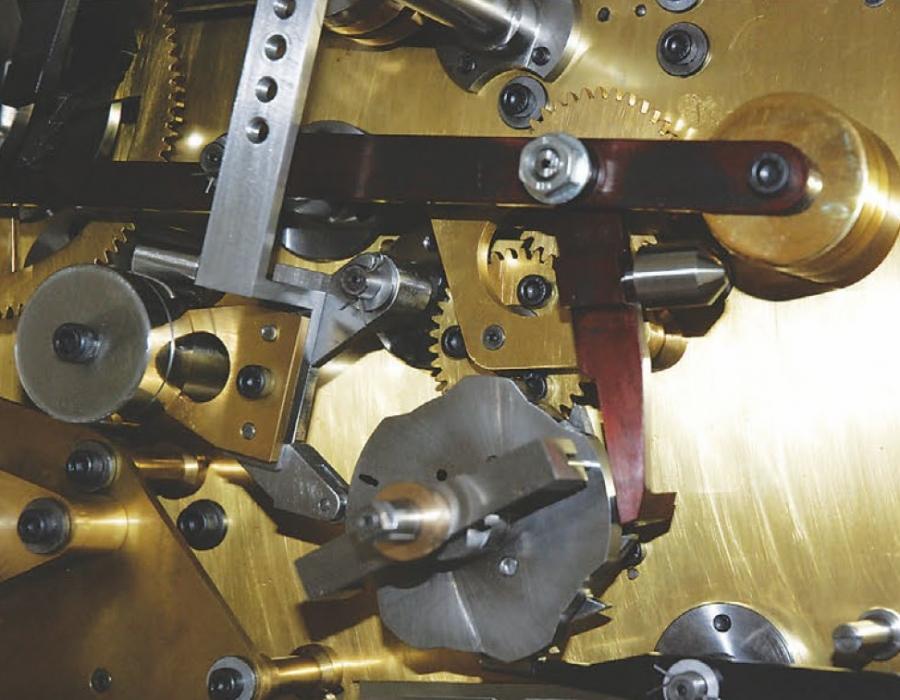
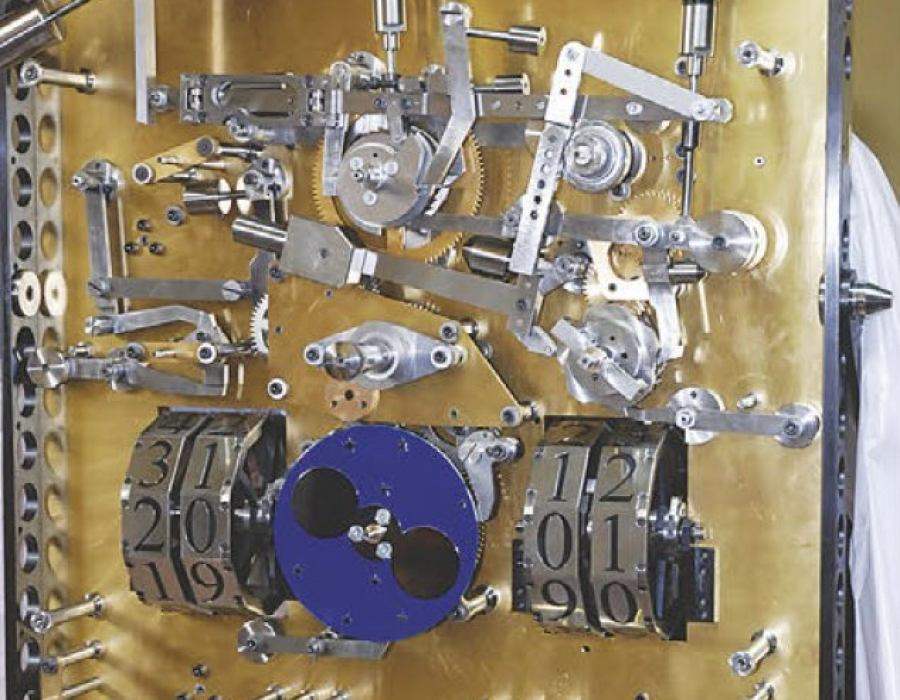
At the top of the main mechanism is the second hand axis which has been integrated with the date axis. The date change is implemented using a cam, an impulse lever and a 31-tooth wheel.
Changing the date to the first day of the month changes the name of the month on the dial on the right-hand side of the mechanism. The mechanism has a complex date correction system depending on the name of the month and whether the year is an ordinary or a leap year.
The automatic date change is carried out using cams, levers and a four-year correction for the number of days in the month of February.
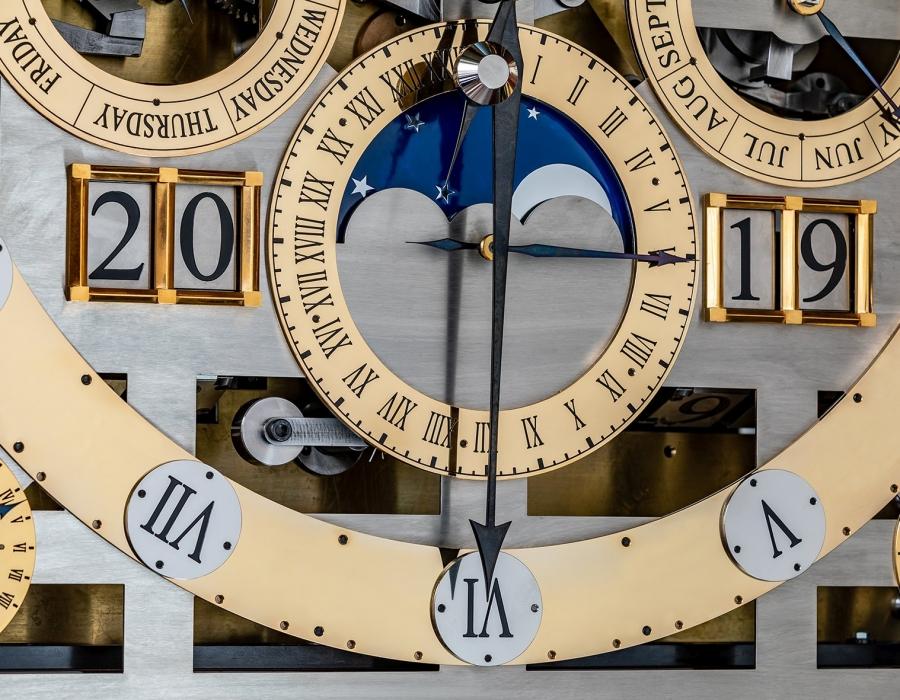
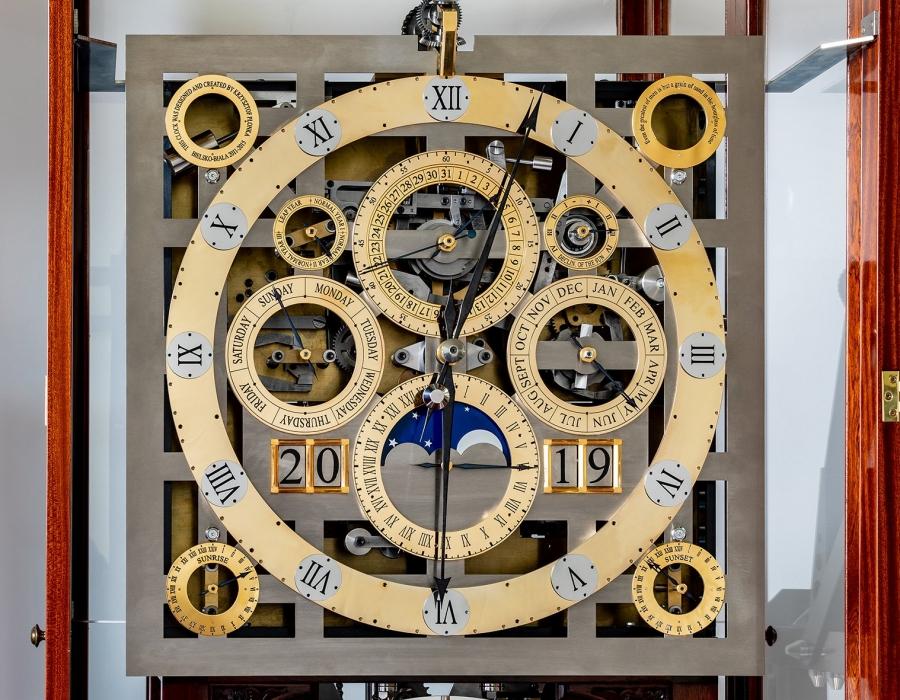
The 24-hour dial, integrated with the moon phase mechanism, is visible at the bottom of the mechanism. The indication of the moon phases is carried out by means of a cam, an impulse lever, and a 59-tooth wheel.
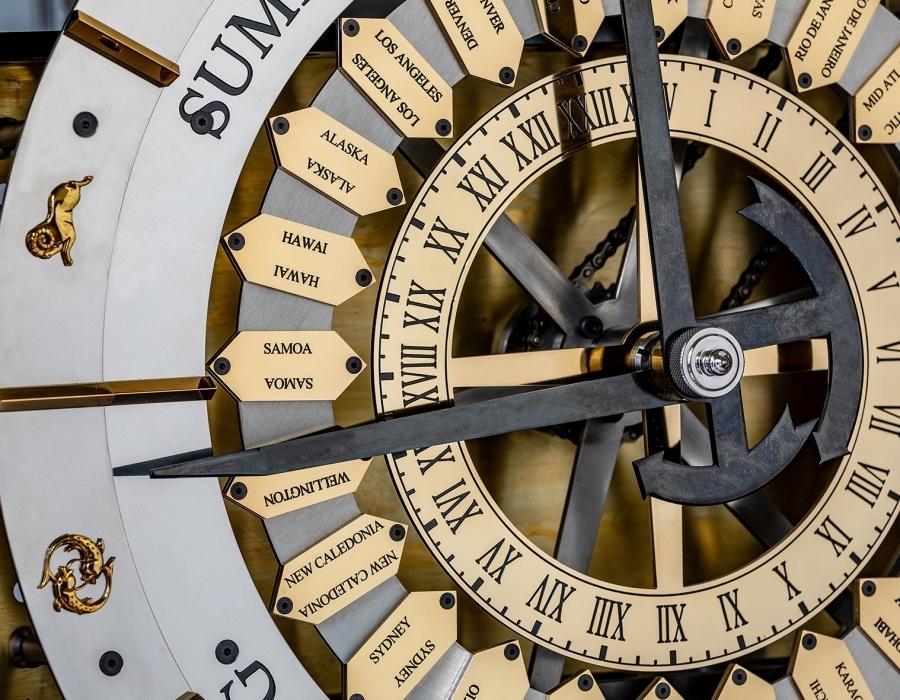
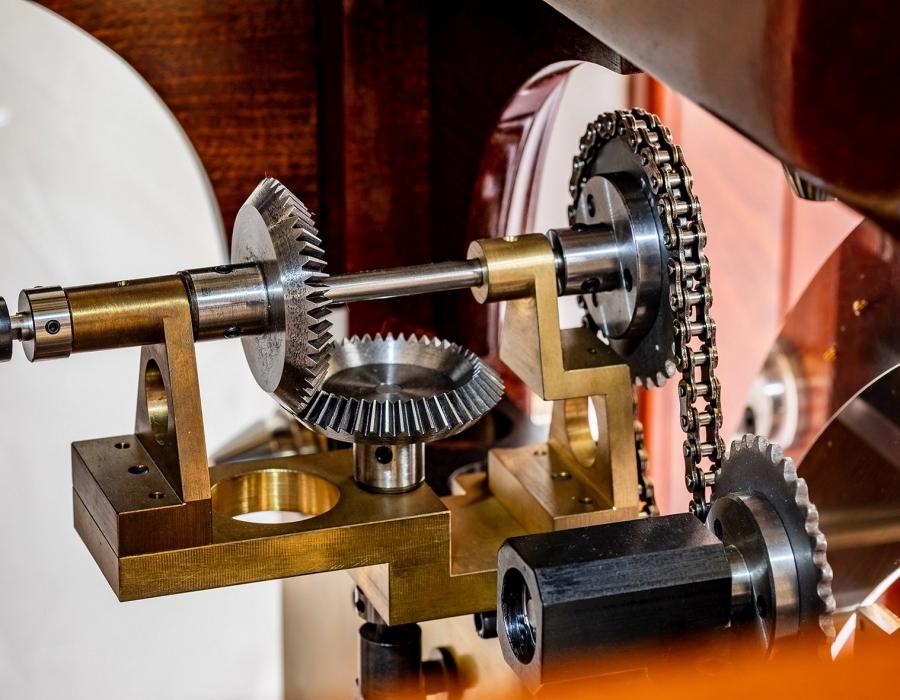
The "time zone" dial rotates via the transmission mechanism.
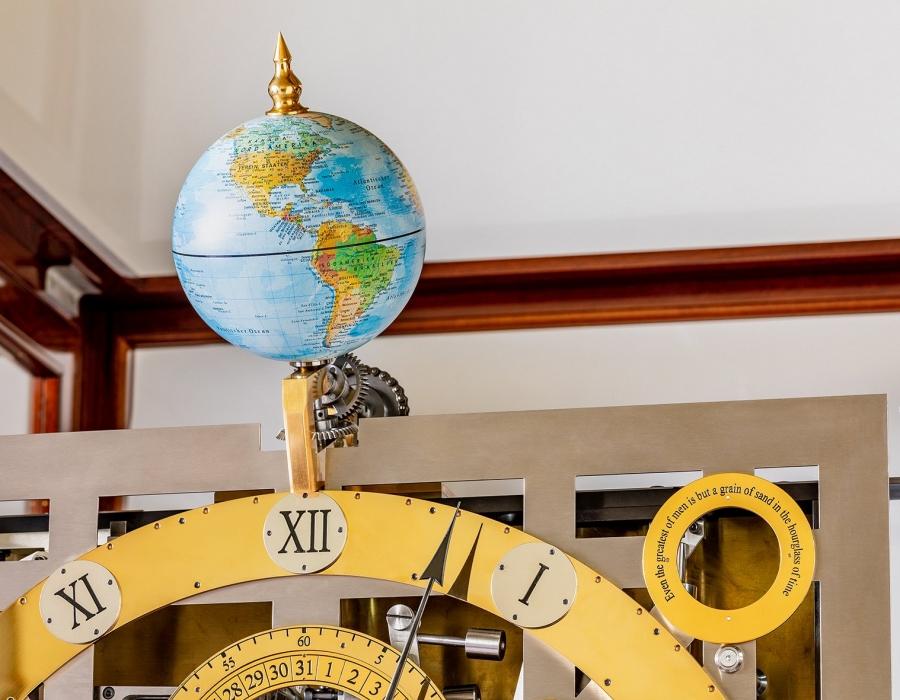
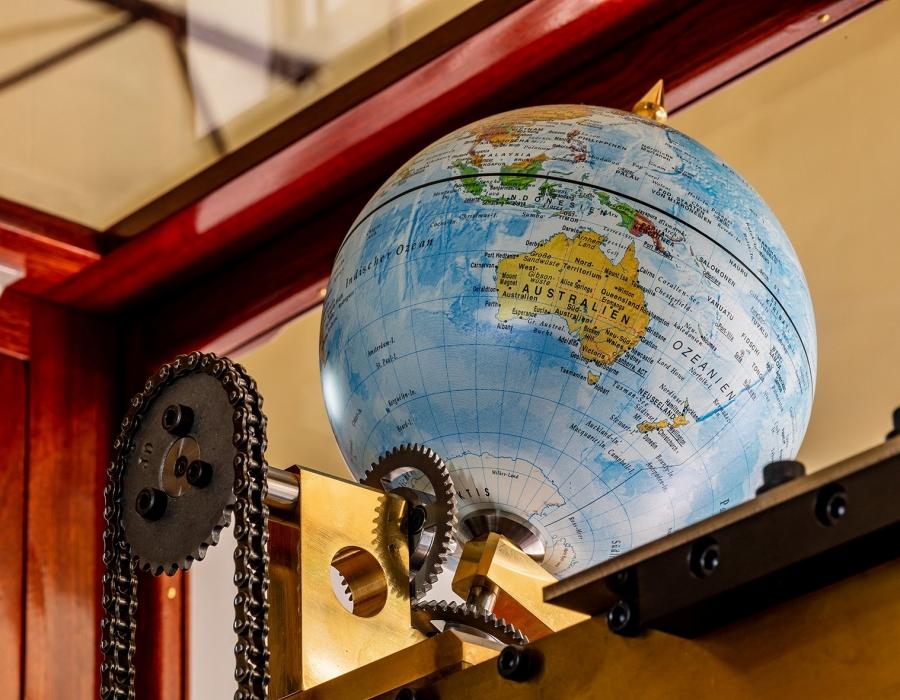
The main mechanism drives the rotation of the globe via a gear and Gall chain.

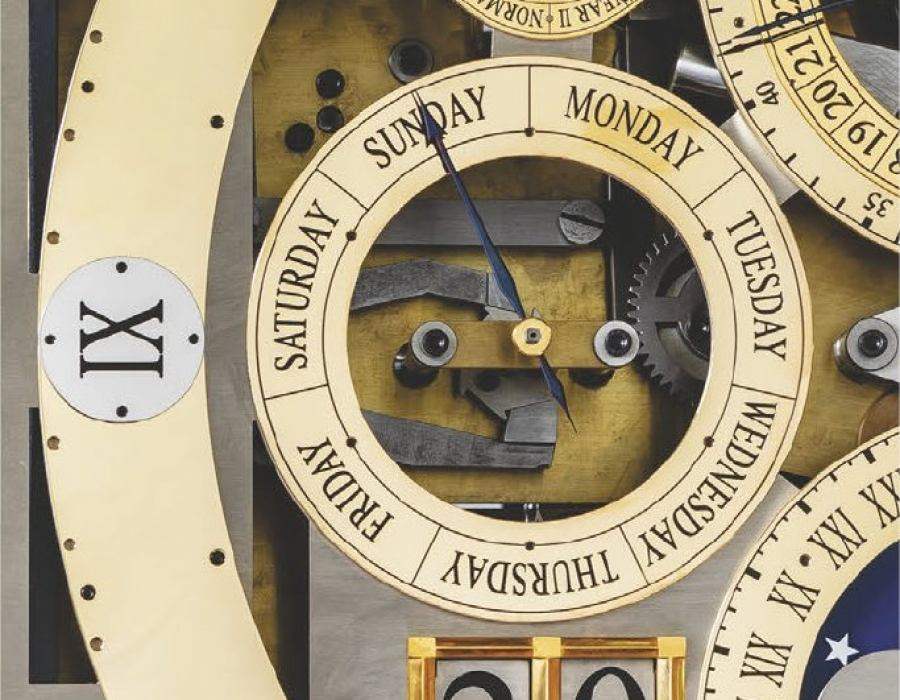
A dial with the names of the days of the week is located on the left side of the main mechanism. Changing the settings is carried out using a ratchet wheel, an impulse lever, and a 7-tooth wheel.
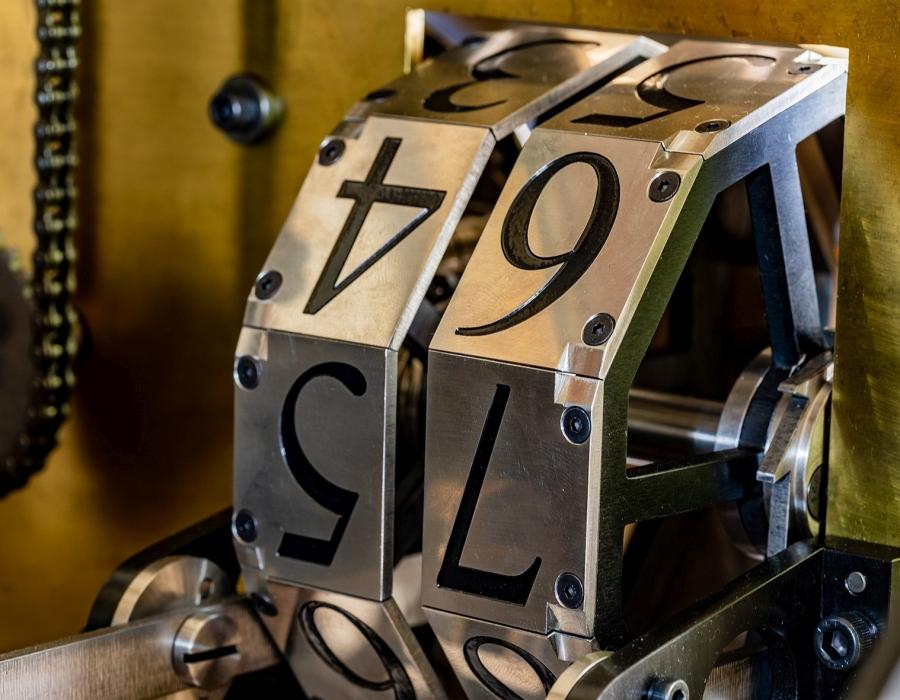
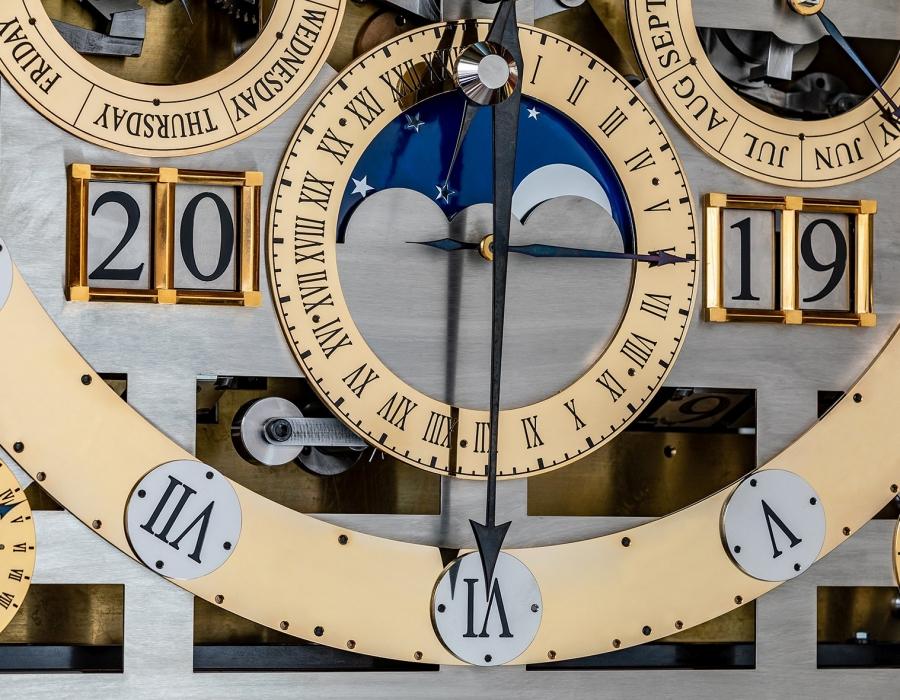
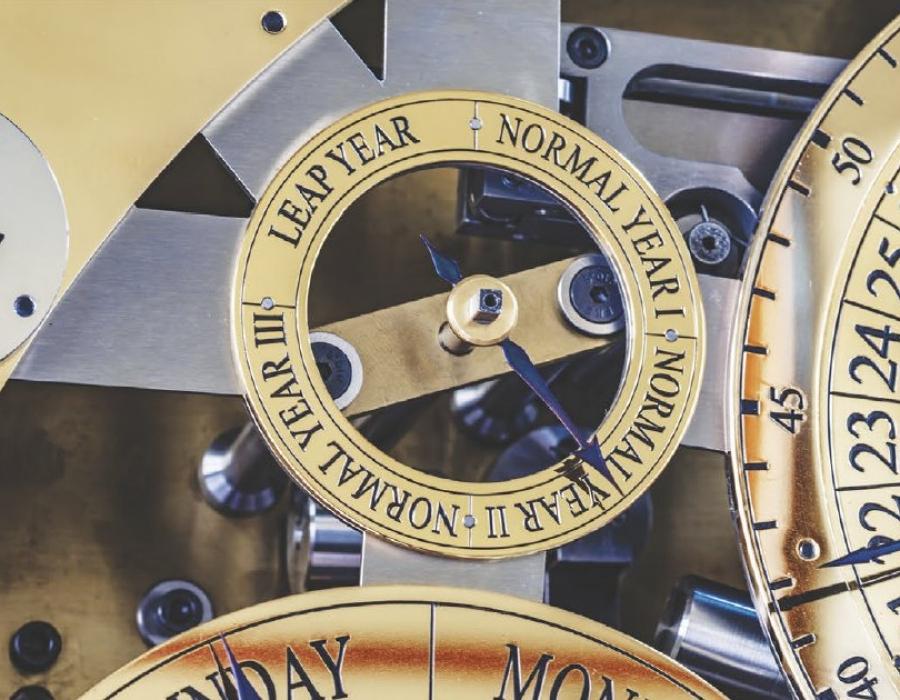
The year indication mechanism located in the four fields of the dial consists of four rotating drums with the numerals 0 to 9. The mechanism automatically changes the year when the month name is changed to January. The mechanical counter changes the display automatically for 99 years. After this period, the settings in the fields on the left-hand side of the dial should be adjusted manually. Each time the year changes, the setting of the indicator on the dial changes – "ordinary years – leap year".

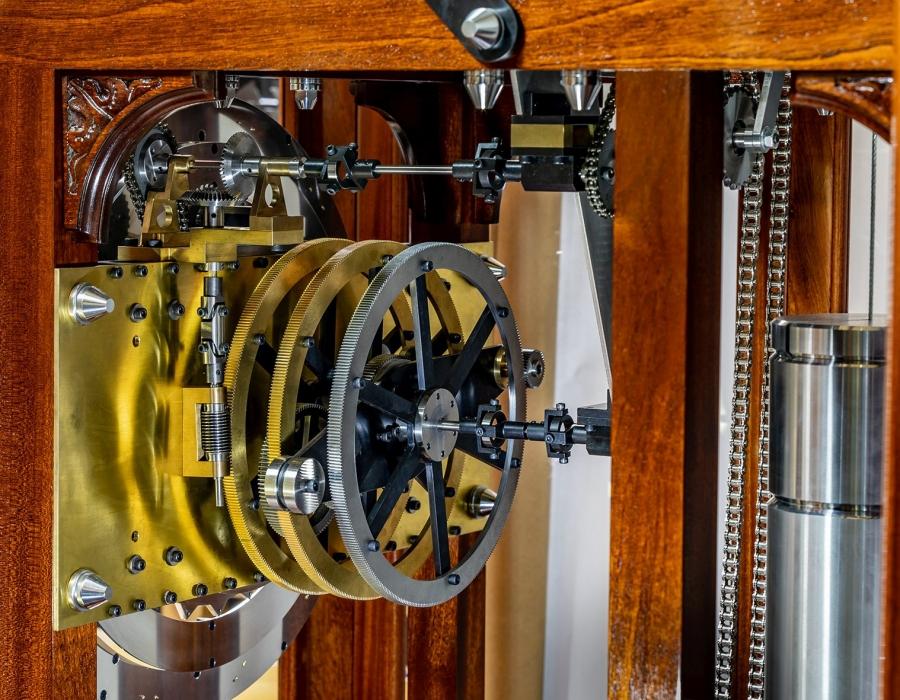
The main mechanism drives the annual gearing at a rate of 1 revolution/365.25 days, which maintains the correct indications over a four-year cycle – no correction required. The drive is carried out by means of the gears of the main mechanism, chain gears of the transmission mechanism, and a worm gear with planetary circulation of the adjuster. The adjuster makes 1 cycle in 4 years. The annual gearbox is responsible for the 'seasons', 'zodiac signs', 'sunrise', 'sunset' and 'sun declination' indications. The above indications have been obtained with gears, levers, and cams making one revolution in 365.25 days.
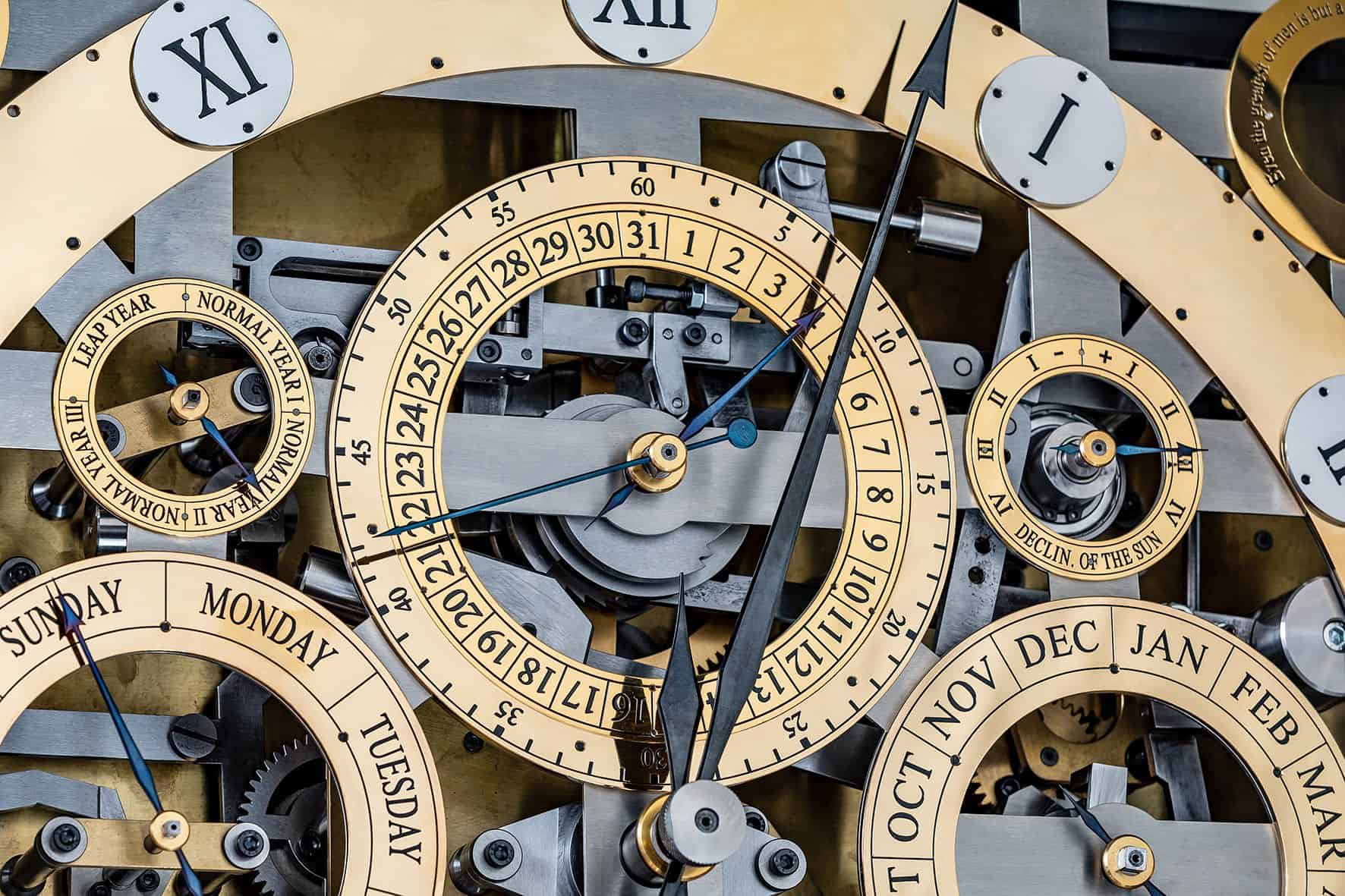
To the left of the date dial is a dial indicating an ordinary or a leap year. The mechanism controls the hands axis using cams, levers, an impulse lever, and a wheel with 8 teeth. The change in indication occurs as the year indication changes.
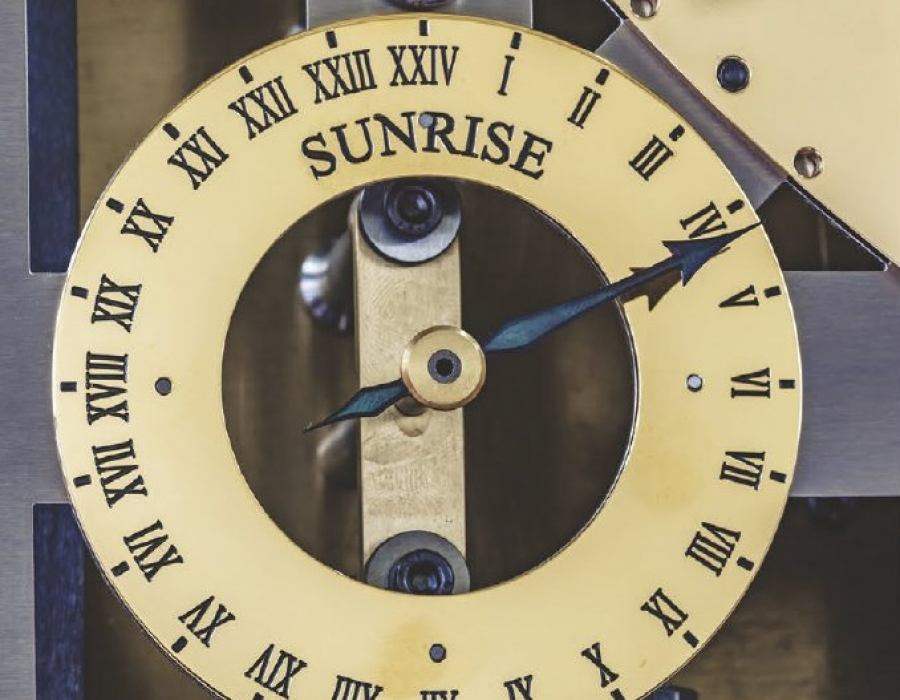
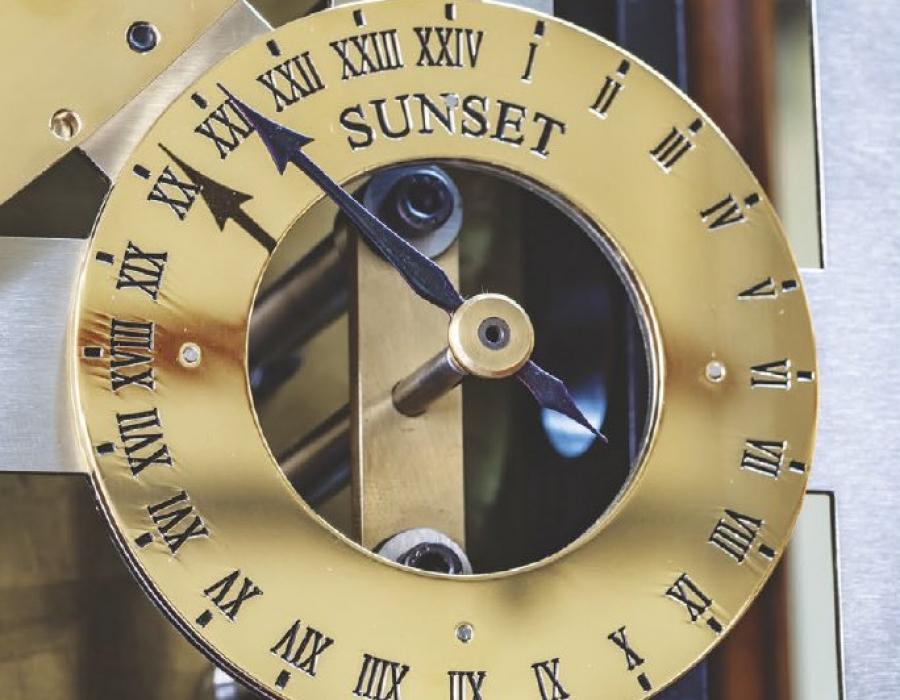
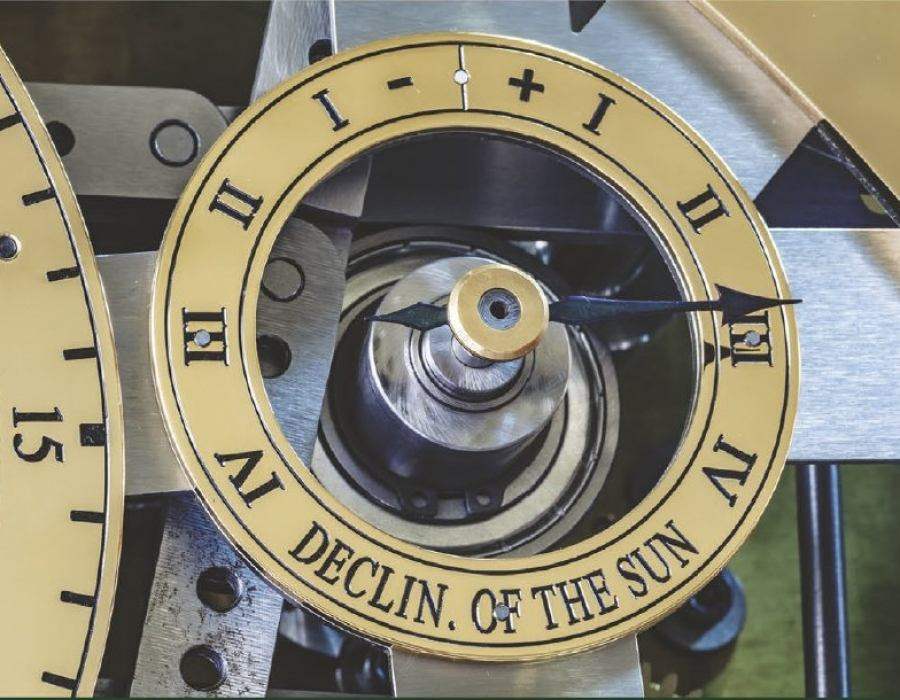
The 'sunrise', 'sunset', and 'sun declination' indications visible on the clock's main dial are driven by an annual gear axis, located at the bottom of the clock, via sprockets, Gall chains, and a cam system. Thanks to this mechanism, information concerning what time of year the sun rises and sets depending on the season is provided. The "sun declination" dial informs us about the daily proportion of day and night hours.
Clock housing
The clock housing consists of a base, and a glazed display case. It has been handmade from mahogany wood and polished. The glazed showcase exposes the extremely complex clock mechanism and enables its operation to be observed.
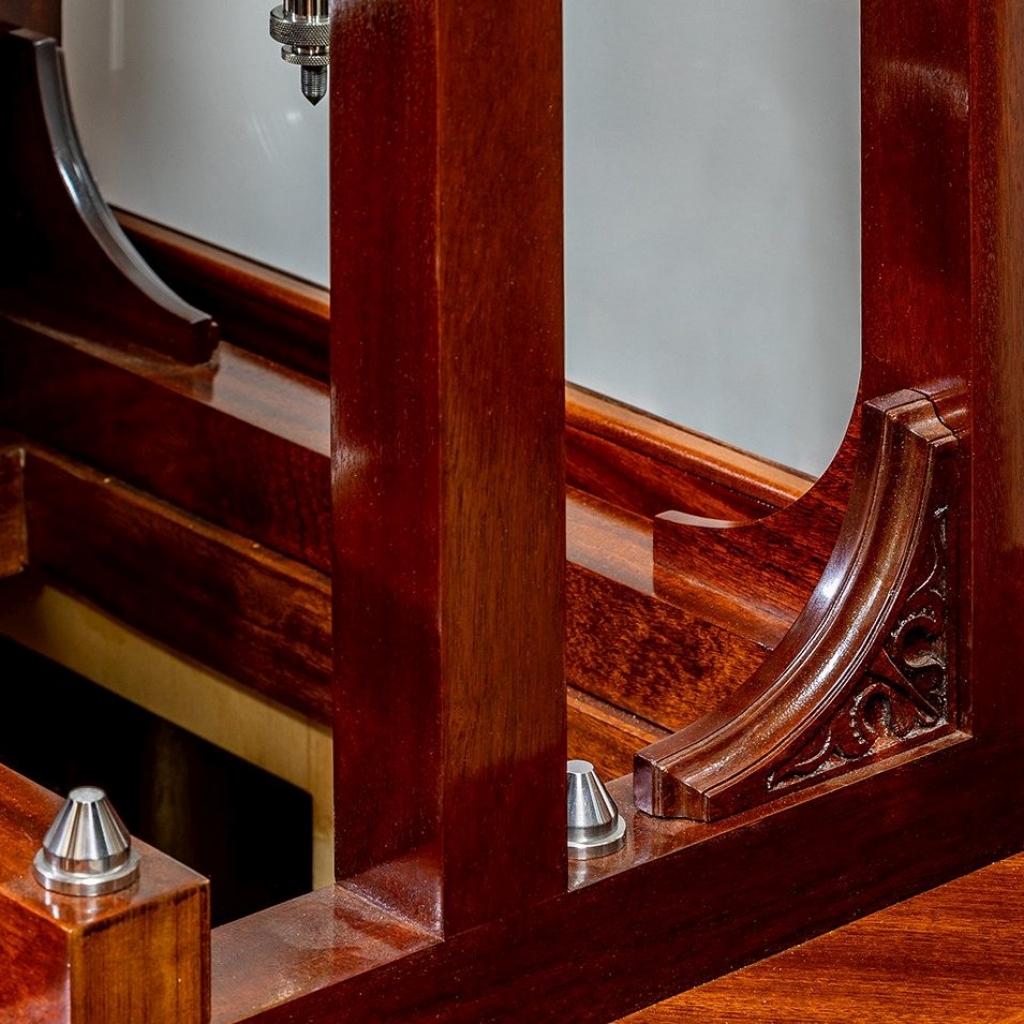
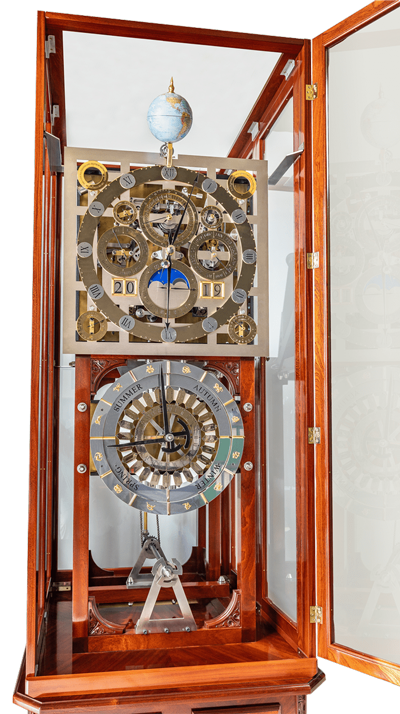
Clock housing
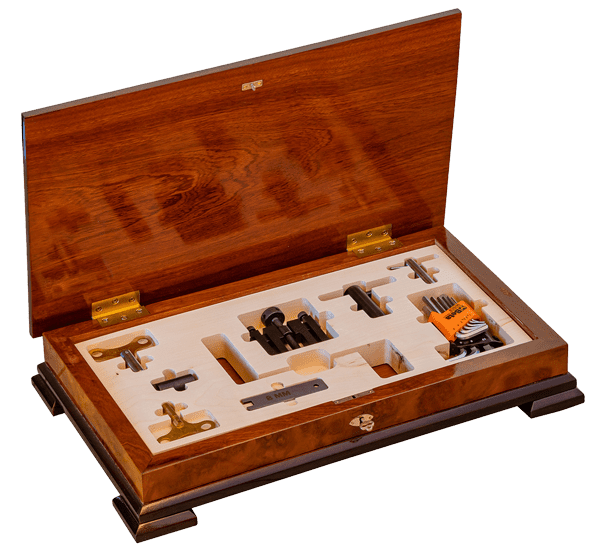
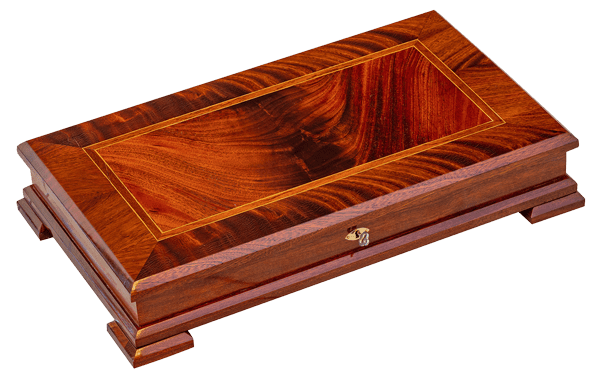
Equipment
The clock is equipped with a box containing a set of tools that may be needed during operation. The equipment includes a crank for winding the clock up, special keys for setting the hands, a universal puller for pulling off the hands and Allen keys.
The tools are housed in a designed and handcrafted box finished in mahogany wood.
Equipment
RULES
Rules for using the clock
Due to its size and weight, the clock must be partially disassembled for transport and then reassembled once in position. The room where the clock is located should be dry and at the right temperature. The clock must not be exposed to shocks. Comprehensive information on the construction and rules of use is provided by the clock maker.
Basic operating principles:
01
The clock is wound up using the crank provided. Systematically check the condition of the weight cable.
02
Only adjust the display using the keys provided.
03
Do not reverse the hands of the clock – you risk damaging the mechanism.
04
If the clock is disturbed, under no circumstances should the mechanism be tampered with. Any faults can only be rectified by a professional.
05
Periodically – every 4 to 5 years – the clock mechanisms should be maintained and lubricated.
Observing these rules ensures the correct operation of the clock for many years.

- Technical data: height – 270cm, width – 100cm, depth – 115cm, weight – approx. 300kg
Krzysztof Płonka
Krzysztof Płonka
He was born in 1952 in Ślemień near Żywiec, where he lived and attended primary school. In 1966, he began studying mechanical engineering, machining and precision mechanics in Bielsko-Biała. He has been self-employed since 1990. Since the beginning of his career, clock constructions have become his lifelong passion.
It deepens the knowledge of the history and construction of mechanical clocks, and at the same time rebuilds unique, antique clocks, restoring them to all functions, which allows them to operate.
In 2005, he obtained a patent for the "Chronometer Clock Grab" No. 204808, which he designed.
During this time, he begins building astronomical clocks of very high complication and "Regulator" type standing clocks.
Currently, he is working on the implementation of Krzysztof Płonka's "Great Astronomical, Figural Tower Clock" and rescues old, antique mechanical clocks from total oblivion by restoring their utility functions.
